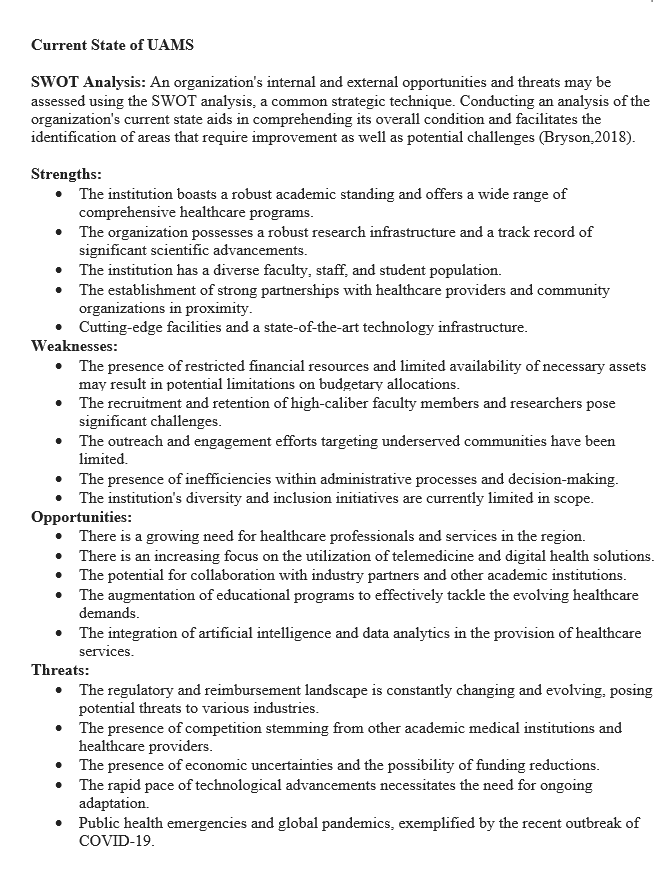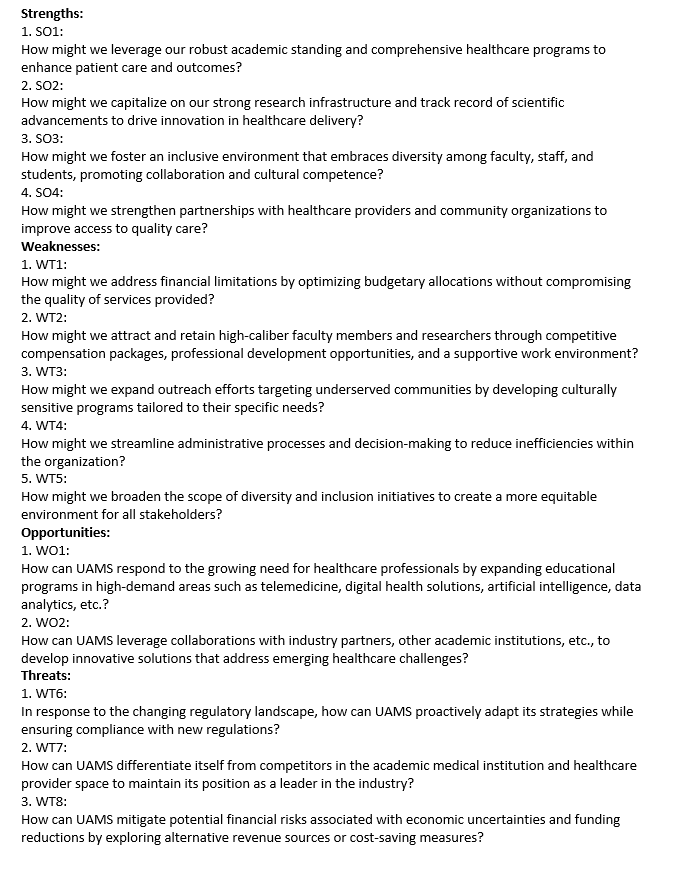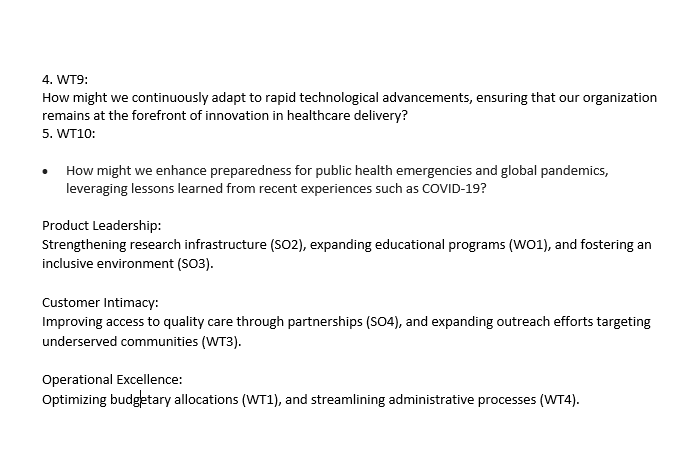Step 1:
Based on your SWOT analysis, explain the Business Level Strategies (Product Leadership, Customer Intimacy, & Operational Excellence Strategies) that will enable your organization to strengthen its organizational capabilities and performance to deliver greater value to those served, thereby enabling your organization to move from its current to its future state or excel at its mission and move towards realizing its vision.
Step 2:
Begin translating your selected Business Level Strategies into Strategic Objectives by explaining the following:
- Desired Results (Greater Value)
- Who are the primary customers who will derive greater value or benefits from your organization over the next 3 to 5 years?
- What greater outcomes of value or desired results must be delivered to each of them over the next 3 to 5 years?
- Key Internal Work Processed (Performance)
- What key internal work processes must be improved or newly adopted to deliver the identified greater value or results to the identified primary customers over the next 3 to 5 years?
- Organizational Capabilities (Human, Informational, &/or Social Capital)
- What aspects of your organizational capabilities must be improved to excel at improving or establishing the identified key internal work processes over the next 3 to 5 years?
Vision Statement for UAMS: Our vision is to become a nationally recognized academic medical center, leading the way in cutting-edge medical research, exceptional patient care, and community health initiatives. By harnessing the power of innovative technologies and championing preventive healthcare, we are committed to providing equitable access to high-quality medical services for all Arkansans.
Mission Statement for UAMS: To enhance the health and well-being of our diverse community through the provision of exceptional patient care, groundbreaking research, comprehensive education, and active community involvement. Our mission is to deliver compassionate and equitable healthcare services, nurture the development of future healthcare leaders, and drive the advancement of medical knowledge for the betterment of all.
Values: At the heart of all UAMS does is a commitment to these core values: excellence; compassion; integrity; diversity; inclusiveness; innovation; and cooperation.



Current State of UAMS SWOT Analysis: An organization's internal and external opportunities and threats may be assessed using the SWOT analysis, a common strategic technique. Conducting an analysis of the organization's current state aids in comprehending its overall condition and facilitates the identification of areas that require improvement as well as potential challenges (Bryson,2018). Strengths: - The institution boasts a robust academic standing and offers a wide range of comprehensive healthcare programs. - The organization possesses a robust research infrastructure and a track record of significant scientific advancements. - The institution has a diverse faculty, staff, and student population. - The establishment of strong partnerships with healthcare providers and community organizations in proximity. - Cutting-edge facilities and a state-of-the-art technology infrastructure. Weaknesses: - The presence of restricted financial resources and limited availability of necessary assets may result in potential limitations on budgetary allocations. - The recruitment and retention of high-caliber faculty members and researchers pose significant challenges. - The outreach and engagement efforts targeting underserved communities have been limited. - The presence of inefficiencies within administrative processes and decision-making. - The institution's diversity and inclusion initiatives are currently limited in scope. Opportunities: - There is a growing need for healthcare professionals and services in the region. - There is an increasing focus on the utilization of telemedicine and digital health solutions. - The potential for collaboration with industry partners and other academic institutions. - The augmentation of educational programs to effectively tackle the evolving healthcare demands. - The integration of artificial intelligence and data analytics in the provision of healthcare services. Threats: - The regulatory and reimbursement landscape is constantly changing and evolving, posing potential threats to various industries. - The presence of competition stemming from other academic medical institutions and healthcare providers. - The presence of economic uncertainties and the possibility of funding reductions. - The rapid pace of technological advancements necessitates the need for ongoing adaptation. - Public health emergencies and global pandemics, exemplified by the recent outbreak of COVID-19. 4. WT9: How might we continuously adapt to rapid technological advancements, ensuring that our organization remains at the forefront of innovation in healthcare delivery? 5. WT10: - How might we enhance preparedness for public health emergencies and global pandemics, leveraging lessons learned from recent experiences such as COVID-19? Product Leadership: Strengthening research infrastructure (SO2), expanding educational programs (WO1), and fostering an inclusive environment (SO3). Customer Intimacy: Improving access to quality care through partnerships (SO4), and expanding outreach efforts targeting underserved communities (WT3). Operational Excellence: Optimizing budgetary allocations (WT1), and streamlining administrative processes (WT4). Strengths: 1. SO1: How might we leverage our robust academic standing and comprehensive healthcare programs to enhance patient care and outcomes? 2. SO2 : How might we capitalize on our strong research infrastructure and track record of scientific advancements to drive innovation in healthcare delivery? 3. SO3: How might we foster an inclusive environment that embraces diversity among faculty, staff, and students, promoting collaboration and cultural competence? 4. SO4: How might we strengthen partnerships with healthcare providers and community organizations to improve access to quality care? Weaknesses: 1. WT1: How might we address financial limitations by optimizing budgetary allocations without compromising the quality of services provided? 2. WT2: How might we attract and retain high-caliber faculty members and researchers through competitive compensation packages, professional development opportunities, and a supportive work environment? 3. WT3: How might we expand outreach efforts targeting underserved communities by developing culturally sensitive programs tailored to their specific needs? 4. WT4: How might we streamline administrative processes and decision-making to reduce inefficiencies within the organization? 5. WT5: How might we broaden the scope of diversity and inclusion initiatives to create a more equitable environment for all stakeholders? Opportunities: 1. WO1: How can UAMS respond to the growing need for healthcare professionals by expanding educational programs in high-demand areas such as telemedicine, digital health solutions, artificial intelligence, data analytics, etc.? 2. WO2: How can UAMS leverage collaborations with industry partners, other academic institutions, etc., to develop innovative solutions that address emerging healthcare challenges? Threats: 1. WT6: In response to the changing regulatory landscape, how can UAMS proactively adapt its strategies while ensuring compliance with new regulations? 2. WT7: How can UAMS differentiate itself from competitors in the academic medical institution and healthcare provider space to maintain its position as a leader in the industry? 3. WT8: How can UAMS mitigate potential financial risks associated with economic uncertainties and funding reductions by exploring alternative revenue sources or cost-saving measures









